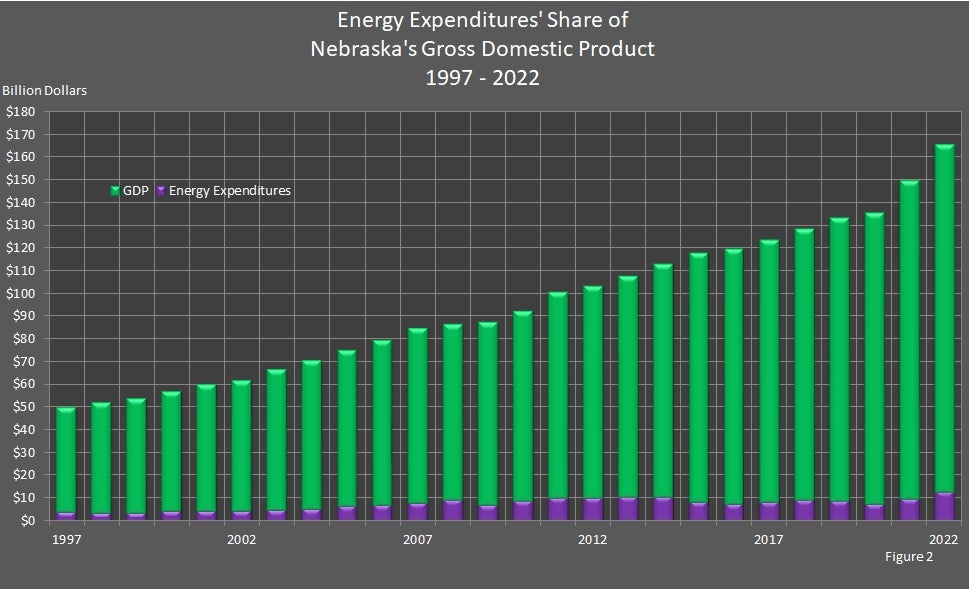Expenditures as a Share of Gross State Profit
In 2022, the state's gross domestic product was $164.9 billion. Energy expenditures in Nebraska accounted for 7.7 percent, or $12.7 billion, of the $164.9 billion.
The ratio of total expenditures for energy relative to Nebraska's total gross domestic product(both in nominal dollars) provides an indication of the importance of energy expenditures in the aggregate economy. The association between energy expenditures and the economic cycle is readily explicable: with energy an important input for firms, a rise in energy prices may represent an adverse supply shock, lowering output and raising the price level. At the same time, higher energy prices erode the purchasing power of households.
The highest percentage during the reviewed years was 10.6 percent in 2008. The 2008 increase in energy expenditures relative to the state gross domestic product probably resulted in a large part from the increase in energy prices.
The phrase "Gross Domestic Product" is replacing the phrase "Gross State Product." Gross domestic product by state is the state counterpart of the nation's gross domestic product, the U.S. Census Bureau's featured and most comprehensive measure of U.S. economic activity. Gross domestic product by state is derived as the sum of the gross domestic product originating in all the industries in a state.


Energy Expenditures as a Percent of Nebraska's Gross Domestic Product
1997 – 2021
| Year | Nebraska's Total Energy Expenditures (Billion Nominal Dollars) | Nebraska's Total Gross Domestic Product (Billion Nominal Dollars) | Nebraska's Energy Expenditures as a Share of Nominal Gross Domestic Product (Percent of Gross Domestic Product) |
|---|---|---|---|
| 2022 | $12.714 | $164.934 | 7.7% |
| 2021 | $9.666 | $146.285 | 6.6% |
| 2020 | $7.637 | $134.581 | 5.7% |
| 2019 | $8.895 | $131.352 | 6.8% |
| 2018 | $9.143 | $124.705 | 7.3% |
| 2017 | $8.245 | $120.517 | 6.8% |
| 2016 | $7.548 | $116.194 | 6.5% |
| 2015 | $8.136 | $115.328 | 7.1% |
| 2014 | $10.339 | $111.162 | 9.3% |
| 2013 | $10.295 | $107.604 | 9.6% |
| 2012 | $10.116 | $102.269 | 9.9% |
| 2011 | $9.991 | $99.613 | 10.0% |
| 2010 | $8.741 | $91.813 | 9.5% |
| 2009 | $7.155 | $86.830 | 8.2% |
| 2008 | $9.103 | $85.201 | 10.7% |
| 2007 | $7.957 | $83.123 | 9.6% |
| 2006 | $7.217 | $78.150 | 9.2% |
| 2005 | $6.448 | $73.959 | 8.7% |
| 2004 | $5.405 | $70.289 | 7.7% |
| 2003 | $4.745 | $66.416 | 7.1% |
| 2002 | $4.198 | $61.604 | 6.8% |
| 2001 | $4.454 | $59.467 | 7.5% |
| 2000 | $4.382 | $56.504 | 7.8% |
| 1999 | $3.601 | $53.689 | 6.7% |
| 1998 | $3.497 | $51.829 | 6.8% |
| 1997 | $3.776 | $49.886 | 7.6% |
Sources: State Energy Price and Expenditure Report. Energy Information Administration, Washington, DC. Nebraska Department of Environment and Energy, Lincoln, NE.
Notes: NA indicates data is not available. Percentages may not equal the ratio of the components due to independent rounding.
Change in industry definitions
There is a discontinuity in the "gross domestic product by state" time series at the year 1997, when the data changed from Standard Industrial Classification (SIC) industry definitions to North American Industry Classification System (NAICS) industry definitions. Since the Bureau of Economic Analysis strongly advises against appending the two data series in an attempt to construct a single time series of gross domestic product from 1963 to 2006, the data in this report cover the time period starting at 1997.